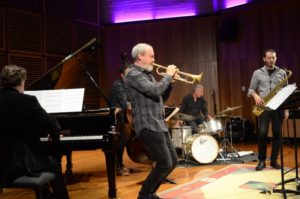Sound Lounge, July 27
9/10
It doesn’t hit full-frontally, but rather slides into your consciousness like a chimera just caught in the corner of your eye. Then it gradually insinuates itself, until the absorption is complete and time seems to stop. Phil Slater has achieved a rare profundity by ruthlessly paring back the component parts of his music, so it was more a latticework of sound than a wall.
Some jazz has been compromised rather than enhanced by all instruments having equal voices in a collective conversation. While the theory was intoxicating and endless brilliant music has resulted, the problem was that, like painting, music of any stripe tends to work better with foregrounds, mid-grounds and backgrounds; when it is dynamically and texturally layered.

This is what Slater’s new music from his The Dark Pattern album restores. His own trumpet, Matt Keegan’s tenor saxophone, Matt McMahon’s piano, Brett Hirst’s bass and Simon Barker’s drums don’t jostle and crowd each other. Instead the collective sound has a translucency, so instruments can be heard through the prism of other instruments, not only because softness is the default dynamic, but because of the prevailing harmonic and rhythmic simplicity.
The lines were often simple, too, yet eerie: melodies that dissolved into a shadowland, with the trumpet, itself, somehow projecting darkness rather than its conventional brightness. Meanwhile Slater sustained an extraordinary breadth of sound, regardless of pitch or volume, which, allied to the shadowy melodic invention, was utterly gripping. It was often also immeasurably sad, although not in the heart-string-tugging way of, say, a Puccini aria, but more obliquely; a sadness that welled up and took you by surprise; that dwelt in the rests as much as the notes. He capped the evening by impaling the room on a solo of simply staggering power.
If I’ve focused on Slater to the exclusion of his exceptional collaborators, it is only because they brought their boundless creativity to bear on the trumpeter’s conception of how an improvising quintet might be liberated by the imposition of constraints. It worked, and was unforgettable.